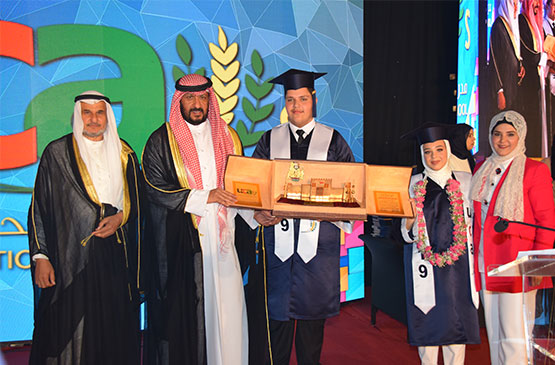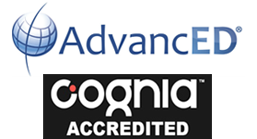
High School
Curriculum:
The middle and high school curriculum aims to reinforce the skills previously learned and continue to support and develop moral, civic and intellectual skills and values.
To achieve these goals, each student must have:
High School Sciences
Biology
Course Description:
Biology provides a review and extension of the Biological principles including: themes of biology, chemistry in the living cells, and biochemistry, which includes: molecules of life and the structures of the cell with the electron microscope. (Homeostasis and transport) Furthermore, this course includes genetics, the fundamentals of genetics, Mendel’s experiments, results and conclusion, the two laws of genetics, nucleic acids with their function and structures and how they share in the structures of proteins in the cell. Finally, the students will study plant structure, function, and reproduction.
Chemistry
Course Description:
Chemistry provides the basis for students to address consumer, health, safety, environmental, technological, societal, and scientific issues on a daily basis. Its content defines the fundamental knowledge and skills necessary for students to develop an understanding of the most basic chemistry concepts associated with structure, form, change, availability, and use of matter and energy. Chemistry’s standards are appropriate for high school students and comprise the basic content to be incorporated into all first-year chemistry courses. Emphasis is placed on the Physical Science domain, but many possible connections to the Earth and Space Science domain as well as to the Life Science domain are made. This chemistry course is laboratory-based and encourages critical thinking and the use of basic chemical concepts and scientific strategies by students as they learn to make intelligent decisions and solve practical problems. Technology is important to this course and is used for measuring, probing, and analyzing matter and energy. Chemistry-related technology includes probe ware and devices such as spectroscopes that can be interfaced with computer- or calculator-based programs in order for data to be acquired directly during investigations both within and beyond the school laboratory. It is also essential that students place theories and discoveries of significant persons into a historical perspective. Students should use clear and accurate language, keep accurate records, make reports, present oral and written projects, and participate in discussions regarding the results and conclusions of scientific investigations.
Environmental Science
Course Description:
Environmental science provides a review and extends to include many types of pollution: air pollution, acid precipitation, atmosphere and climate change, the importance of the ozone shield, how we use land, urban land use, food and agriculture, feeding the world, crops and soil, mining and mineral resources, and mineral exploration and mining. Moreover, the student differentiates between nonrenewable energy including: energy resources and fossil fuels, and renewable energy and alternative energy. Finally, the student should define solid waste and hazard waste.
Physics
Course Description:
Most of the phenomena in the world around you are, at the fundamental level, based on physics, and much of physics is based on mechanics. Mechanics begins by quantifying motion, and then explaining it in terms of forces, energy and momentum. This allows us to analyze the operation of many familiar phenomena around us, but also the mechanics of planets, stars and galaxies. This on-demand course is recommended for senior high school students. The course has a range of interesting practice problems, at-school and at-home experiments, using simple, everyday materials. Prerequisite courses include: Algebra I, Algebra II, Geometry, and Trigonometry. By studying mechanics, the student will understand with greater depth many of the wonders around his/her everyday life, in technology, and in the universe, at large.
High School Mathematics
Geometry
Course Description:
Students study geometry as a mathematical system through studying circles, chords, secants, tangents segments, finding the area, perimeter, coordinate geometry, and surface area and volume of solids. This course will help students develop more advanced mathematical skills through learning the deductive development of relationships in the plane and space developed intuitively in previous years. Students study congruent segments and angles, secants and tangent segments, parallel and perpendicular lines, angle measure in triangles, transformations, the Pythagorean Theorem, and coordinate geometry.
Algebra II
Course Description:
This course will help students develop the skills as a mathematical system through studying systems of equations and inequalities, exponents and exponential functions, factoring, functions and systems, quadratic equations and functions, polynomial expressions, and the elementary properties of functions. Mathematical modeling of real-life problems and problem solving are major themes of the course.
Pre-Calculus:
Course Description:
Pre-calculus completes the formal study of the elementary functions begun in Algebra 1 and geometry. Students focus on solving problem involving trigonometric functions, their inverses, complex numbers, and quadratic relations. The course also includes the study of relations and functions, exponential and logarithmic functions, trigonometry in triangles, trigonometric functions, identities and equations.
Integrated Math 2:
Course Description:
Math Matters 2 provides a review and extension of the concepts taught in algebra and geometry. Topics covered will include: equations and inequalities, coordinates and graphs, general functions, polynomial and rational functions, exponential and logarithmic function, trigonometric functions of angles and of real numbers, analytic trigonometry, systems of equations and inequalities, sequences and series, identifying the fundamentals geometric and basic geometric postulates, congruent triangles, polygons and circles. Throughout this course, students will develop learning strategies, critical thinking skills, and problem solving techniques to prepare for future math courses and college entrance exams.
Integrated Math 3:
Course Description:
Integrated Math 3 introduces students to plane geometry with integration of some space and coordinate geometry. Furthermore, concepts of transformational geometry, measurement, and the basic concepts of right triangle trigonometry will be taught. This class develops geometric concepts using algebraic application. Algebra is used extensively for areas, volumes, lengths, angle measurements, and graphing. Topics covered will include: equations and inequalities, coordinates and graphs, general functions, polynomial and rational functions, exponential function, systems of equations and inequalities, sequences and series. Throughout this course, students will develop learning strategies, critical thinking skills, and problem solving techniques to prepare for future math courses and college entrance exams.
Calculus:
Course Description:
This course is designed to introduce students to selected concepts of calculus and is not as rigorous as the Advanced Placement courses. It introduces the basics of limit, differential and integral calculus, and their applications. Topics include the slope of a curve, the rate of change of a function, properties of limits, derivatives of algebraic and trigonometric functions, extrema, the Mean Value Theorem, integration, area and volume.
High School English:
The high school curriculum strives to refine research and writing skills and places emphasis on mastering the conventions of Standard English. The curriculum gives students the opportunity to enhance their knowledge of the English language and to be able to recognize and understand the use of a variety of literary elements. Historical periods and writers and poets of these periods are studied in the eleventh and twelfth grades.
Grade 9:
Grade Nine Language Arts Program continues improving and building reading, writing, listening, and speaking skills. Course components include the study of a variety of literature, writing in the genres of narrative, persuasive, expository, and increasing vocabulary development, spelling, and grammar. Also, increasing development of oral and written language activities in an integrated and inter-related manner with direct instructions in language arts, skills and strategies.
Grade 10:
Grade Ten Language Arts Program emphasizes the use of written language for educational and personal endeavors. Preparation will include critiquing oral presentations and using speaking and listening skills while reading and writing. This course is designed to give students an opportunity to enhance vocabularybuilding skills and to recognize and understand the use of a variety of literary elements.Students will learn to respond to a wide range of literature using intelligent and thoughtful analysis. Students will engage in daily and longer-term projects, in order to develop critical thinking and research skills. This course will prepare students for higher-level English courses and university.
Grade 11:
Grade 11 Language Arts Program emphasizes, refines, and enhances a fundamental literary and communication skills. Indeed, English Language Eleven represents another leap in academic rigor and depth. Beginning in grade eleven, the students will explore the history of the English language. Literary periods and writers and poets of literary periods will be studied. At the end of the year, the students will be required to produce a historical research paper, as this follows their study of the history of the English language. This course will prepare students for higher-level English courses and university.
Grade 12:
English Language Twelve provides focus and polish in personal goals and academic proficiency. Grade twelve students continue to study the historical aspects of the English language. Experiences such as a senior project and a sophisticated research paper (literary subject) culminate the students’ high school language experience. Readiness for the work place or post secondary school is the final reality check. The expansion and appreciation of language and literature is the focus of the senior year. This course will prepare students for university.
Islamic History
Grade 12:
Studying history provides a student with skills which are not confined to the study of the past. Skills of analysis are invaluable in many jobs and the ability to analyze and then priorities information is vital to decision making. This not only provides a skills set for a student but it also keeps career options open. Islamic History allows the students to gain knowledge of history and religion. The following topics are taught and discussed:
- The Arabian Peninsula before Islam and how God prepared it to receive the Message.
- The Prophet received the Message and to spread it through the Arabia.
- The Message was spread outside Arabia.
- The Islamic states from the era of the Rashidun Caliphate till the Ottoman Empire.
- The Islamic civilization and its achievements in science, math, medicine, geography, astronomy, geometry and literature.
- skills needed to interact with culturally diverse people
- skills in various subjects
- needed to become successful citizens and life-long learners

